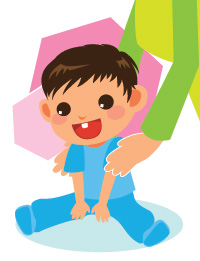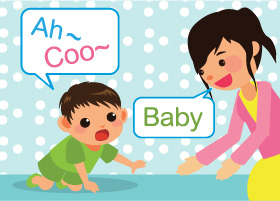Q: I am happy to see that my baby is finally teething! Will teething lead to fever and diarrhea?
Teething will not lead to fever and diarrhea. However, as babies like to chew things when teething, it is more likely for them to get infected. If your baby has fever, and has symptoms like running nose, diarrhea or vomiting, you should bring your baby to the doctor immediately.
The following are the common signs of teething:
- Gum swelling
- Itchy gums
- Drooling
- Agitation and crying

Q: Does my baby have any problem if she can't roll over by 6 months old?
Not every baby at 6 months old will roll over. Sometimes, environmental factors such as wearing too many clothes in winter will stop a baby trying to roll over. Some babies may sit or crawl without experiencing rolling over, and some may learn it at a later stage. Every baby has his or her own pace in development. Therefore a 6-month-old not rolling over does not mean that she has problem. You may observe your baby in different aspects of development. If she seldom wiggles her limbs or moves her limbs asymmetrically, does not support her head well in sitting position, or does not support herself with her legs when being held up, you need to consult the doctor or nurse.
Q: For how long can a 6-month-old baby sit? Would sitting too much affect his spine?
When your baby reaches 6 months old, you can support him by holding him, let him lean onto a pillow or support himself with his hands while putting him in a sitting position. In this way, you are helping him to learn to sit with balance. As babies at this stage are unable to sustain their attention and physical strength, you should change his position of your baby or let him take some rest when he looks tired or agitated. Putting baby in a sitting position for a while will not affect his spine. To promote his development, always give chances for your baby to try when he is interested in an activity.

Q: I notice that my baby's legs appear curved. Does it occur with other babies?
All newborn babies' legs are not straight. it is common to have a mild curving outwards at the kness. It requires no medical treatment. As they grow and begin to stand and walk, the bowed appearance will be reduced and their legs will straighten at around the age of two. If you think the bowing is serious, asymmetrical or not improve with age, you may need to seek medical advice.
Q: My baby is so quiet and I am worried that he may be dumb. How could I help him to make more sounds?
Both genetic and environmental factors are important for language development. In order to make sounds and talk, a baby must have normal hearing, normal oral and vocal structures, normal brain development and cognitive functioning, as well as good intention to communicate with others. Besides, baby's temperament would also affect whether he would like to express himself in sounds. Active and outgoing babies are more likely to express in sounds than the quiet and passive babies.
Actually all babies are born with a voice. The so-called “dumb” is usually due to the child's inability to imitate speech as a result of congenital hearing loss. In such case, even a baby with congenital hearing impairment can still babble like “Ba Ba” or “Da-Da-Da” at 4 to 7 months.
It is important to foster a suitable language environment for your baby to encourage him babbling and learning to talk. You can communicate with your baby by:
- Using lively facial expressions and tones of voice;
- Praising your baby heartily when he tries to imitate your sound;
- Repeating his sounds after your baby responds to you;
- Talking to your baby often to increase the chance for him to try to imitate your words.
Every child varies in their pace of language development. There is no need to be over-alarmed about your baby's language development. However, if your baby has already reached 7 months old but does not turn his head to the source of sounds or when being called; or he rarely makes any sounds or is suspected to have other hearing or language development problems, please consult health professionals for help.

Q: The eyes of my baby sometimes turn inward. Does she have crossed eyes?
When a baby's eye(s) turns inwards, she may have esotropia or crossed eyes. However, the eyes may look “crossed” due to facial appearances, and this is called “pseudo-esotropia”.
Esotropia should be distinguished from “pseudo-esotropia” as it should be evaluated early. Esotropia can be caused by problems of muscles that control movement of the eyes or problems of the nervous system. The affected eye or eyes turns in towards the nose. As a result, the two eyes look at different direction. Esotropia also occurs in infants or children with significant far-sightedness. These conditions require treatment and early correction to ensure normal visual development and to curb the development of amblyopia.
“Pseudo-esotropia” means that the eye(s) has the false appearance of turning inward, but in fact the eye(s) is normal. The illusion is related to the skin fold at the inner corner of the eyelids is broad and nasal bridge is flat and broad. The sclera (white part of the eye ) between the iris (colour part of the eye) is, therefore, narrow, giving an appearance that the eyes moving in towards the nose. It is often seen in Asian babies and children. “Pseudo- esotropia” does not require treatment and the appearance usually improve with time.
If you suspected your child having “crossed eye(s)”, you should seek medical advice for necessary examination and management.
However if her eyes “turn inward” only when she is looking at objects holding at a very near distance, you don't need to worry since it is a normal accommodation reaction.
Q: How can I encourage my baby boy to crawl?
Babies will try to shuffle their body or crawl when they can sit on their own. Sometimes, they may simply sit and shuffle their hips, crawling forward or backward, or even rolling on the floor. You can encourage your baby to move forward by tempting him with toys. Nonetheless, not every baby would have the experience in crawling. Some babies can walk without going through crawling. Therefore, don't be frustrated or force your baby if he has no intention to crawl.
When your baby starts to crawl, you must ensure home safety measures in the areas within his reach.
Q: What can I do if my baby has constipation?
If your baby has dry and hard stool, it may cause tearing of the anal tissue when the stool passes through the anus, which is very painful. In order to avoid the pain, the baby will refuse bowel opening and the condition will worsen. To improve stool consistency, beware of the following points:
First, if the baby has just changed to follow-on formula milk, the stool will become harder. Follow-on formula generally has lower whey-to-casein protein ratio than infant formula, which takes longer time to digest. Thus constipation may be easier to occur. Actually, if your baby is feeding well on solid foods, you can continue feeding him with the more easily digestible infant formula.
Secondly, after introducing solid foods to your baby, you need to make sure that your baby is having enough water, in addition to fruits and vegetables for fibre intake. Mashed apple, pear, broccoli and spinach are good choices.
If you have tried all the methods mentioned above and your baby's condition still not improved, or if your baby is having abdominal distension or blood in the stool, you should consult a doctor. Finally, do not use any laxatives or enemas by yourself as these may cause adverse effects to your baby.

